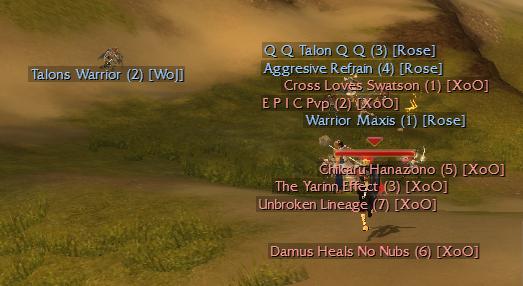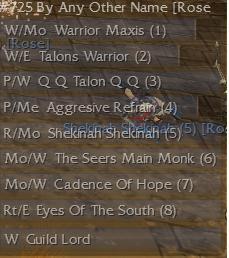Telegraph
About telegraphing[edit]
In Guild Wars, to telegraph means to act in a way that reveals your upcoming actions to your opponents. It is as if in chess you moved a knight to a place where he could attack the king on the next turn, or going to a sniping point in a shooter game. In Guild Wars there are a few notable telegraphs. In most cases you can even prevent the telegraphed action.
Adrenaline spikes and telegraphing[edit]
When you hold down the control key, the names of all visible characters and npcs are shown on your screen. From the monks perspective this can be the single most useful tool for pre-protting and predicting where to send your infuse. For a mesmer, you can easily locate the enemy monks to diversion or otherwise disable. You will note that most top level teams will order their parties in a logical manner (warriors on top, monks on the bottom, etc)
You can quickly find a particular character because of this. Melee are typically (1), (2), and/or (3). Midline characters are typically 3-5, monks are typically 6 and 7, and the flagger is typically 8. Some other arrangements put monks in the center two slots or are staggered 4/4 or 3/5, indicating a prepared split.
When you face a typical pressure build, you will be able to tell when and where a spike is going by watching their warriors. Enemies 1 and 2 will converge on one of your allies when the spike is to happen. Use your party members window to target that ally and throw a prot at him. Feel free to hold down the control key while you do this so you can announce a spike in progress. Higher end teams will also feint the spike, so be prepared to throw two prots (protection spells) at separate allies. A monk with Spirit Bond can more effectively stop this kind of spike than one with Protective Spirit. Make a mental note of which numbers are the warriors so you can effectively stop their spikes.
Telegraphs and Caster spikes[edit]
A typical spike build consists of several casters of the same kind. While your monks are responsible for stopping such spikes damage after it hits, its your disruption's job to stop it before it hits. Almost all of these spikes start with a 2 second cast skill. Some spikes will precede this skill with Glyph of Lesser Energy, or the spike has preparation involved, such as Phantom Pain, Enfeebling Blood, and Nightmare Weapon. Your ranger or mesmer is the disruption, so this character will be responsible for watching and interrupting key preparative skills. In some cases this character can find the target caller and, with an interrupt, completely prevent a spike (especially for an Oppressive Gaze spike). A mesmer with Cry of Frustration can prevent most of the damage from usual caster spikes.
Other noticable telegraphs[edit]
- In Heroes' Ascent battles, watch for large team movements towards your Ghostly Hero or to your resurrection shrine, as this indicates the enemy team will try to take these out.
- In arenas, a ranger with the necromancer secondary profession carrying a staff is typically a touch ranger.
- in Guild battles, an enemy team may linger between the center of their base and their back door, indicating they will try to split.
- Most casters will stop moving half second before they cast something. You can usually interrupt hard to catch spells like Zealous Benediction by being prepared to hit the interrupt skill when they stop. For mesmers, you will get better mileage out of Diversion by using it when your target stops moving.

